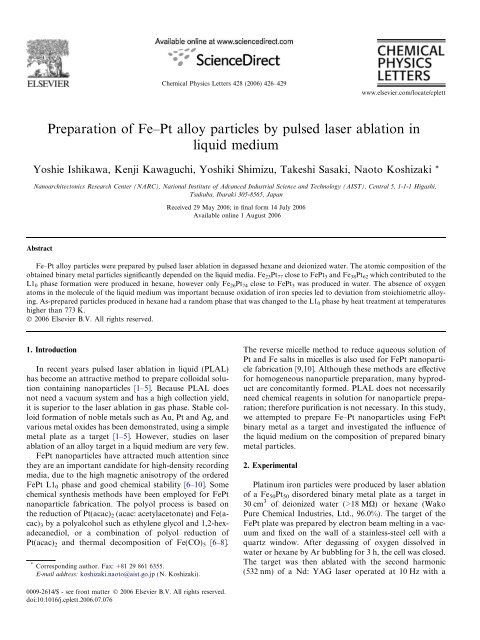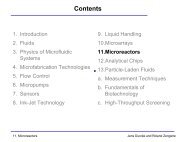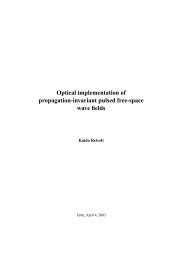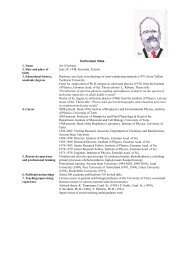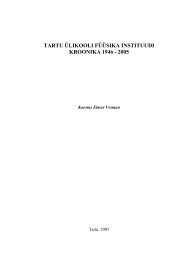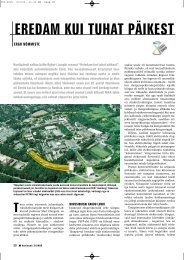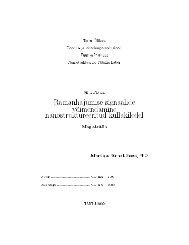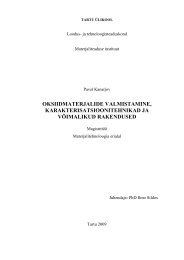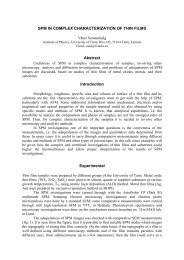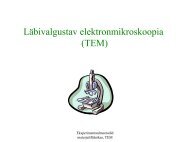Preparation of Fe-Pt alloy particles by pulsed las...
Preparation of Fe-Pt alloy particles by pulsed las...
Preparation of Fe-Pt alloy particles by pulsed las...
You also want an ePaper? Increase the reach of your titles
YUMPU automatically turns print PDFs into web optimized ePapers that Google loves.
Chemical Physics Letters 428 (2006) 426–429<br />
www.elsevier.com/locate/cplett<br />
<strong>Preparation</strong> <strong>of</strong> <strong>Fe</strong>–<strong>Pt</strong> <strong>alloy</strong> <strong>particles</strong> <strong>by</strong> <strong>pulsed</strong> <strong>las</strong>er ablation in<br />
liquid medium<br />
Yoshie Ishikawa, Kenji Kawaguchi, Yoshiki Shimizu, Takeshi Sasaki, Naoto Koshizaki *<br />
Nanoarchitectonics Research Center (NARC), National Institute <strong>of</strong> Advanced Industrial Science and Technology (AIST), Central 5, 1-1-1 Higashi,<br />
Tsukuba, Ibaraki 305-8565, Japan<br />
Received 29 May 2006; in final form 14 July 2006<br />
Available online 1 August 2006<br />
Abstract<br />
<strong>Fe</strong>–<strong>Pt</strong> <strong>alloy</strong> <strong>particles</strong> were prepared <strong>by</strong> <strong>pulsed</strong> <strong>las</strong>er ablation in degassed hexane and deionized water. The atomic composition <strong>of</strong> the<br />
obtained binary metal <strong>particles</strong> significantly depended on the liquid media. <strong>Fe</strong> 23 <strong>Pt</strong> 77 close to <strong>Fe</strong><strong>Pt</strong> 3 and <strong>Fe</strong> 38 <strong>Pt</strong> 62 which contributed to the<br />
L1 0 phase formation were produced in hexane, however only <strong>Fe</strong> 26 <strong>Pt</strong> 74 close to <strong>Fe</strong><strong>Pt</strong> 3 was produced in water. The absence <strong>of</strong> oxygen<br />
atoms in the molecule <strong>of</strong> the liquid medium was important because oxidation <strong>of</strong> iron species led to deviation from stoichiometric <strong>alloy</strong>ing.<br />
As-prepared <strong>particles</strong> produced in hexane had a random phase that was changed to the L1 0 phase <strong>by</strong> heat treatment at temperatures<br />
higher than 773 K.<br />
Ó 2006 Elsevier B.V. All rights reserved.<br />
1. Introduction<br />
In recent years <strong>pulsed</strong> <strong>las</strong>er ablation in liquid (PLAL)<br />
has become an attractive method to prepare colloidal solution<br />
containing nano<strong>particles</strong> [1–5]. Because PLAL does<br />
not need a vacuum system and has a high collection yield,<br />
it is superior to the <strong>las</strong>er ablation in gas phase. Stable colloid<br />
formation <strong>of</strong> noble metals such as Au, <strong>Pt</strong> and Ag, and<br />
various metal oxides has been demonstrated, using a simple<br />
metal plate as a target [1–5]. However, studies on <strong>las</strong>er<br />
ablation <strong>of</strong> an <strong>alloy</strong> target in a liquid medium are very few.<br />
<strong>Fe</strong><strong>Pt</strong> nano<strong>particles</strong> have attracted much attention since<br />
they are an important candidate for high-density recording<br />
media, due to the high magnetic anisotropy <strong>of</strong> the ordered<br />
<strong>Fe</strong><strong>Pt</strong> L1 0 phase and good chemical stability [6–10]. Some<br />
chemical synthesis methods have been employed for <strong>Fe</strong><strong>Pt</strong><br />
nanoparticle fabrication. The polyol process is based on<br />
the reduction <strong>of</strong> <strong>Pt</strong>(acac) 2 (acac: acetylacetonate) and <strong>Fe</strong>(acac)<br />
3 <strong>by</strong> a polyalcohol such as ethylene glycol and 1,2-hexadecanediol,<br />
or a combination <strong>of</strong> polyol reduction <strong>of</strong><br />
<strong>Pt</strong>(acac) 2 and thermal decomposition <strong>of</strong> <strong>Fe</strong>(CO) 5 [6–8].<br />
* Corresponding author. Fax: +81 29 861 6355.<br />
E-mail address: koshizaki.naoto@aist.go.jp (N. Koshizaki).<br />
The reverse micelle method to reduce aqueous solution <strong>of</strong><br />
<strong>Pt</strong> and <strong>Fe</strong> salts in micelles is also used for <strong>Fe</strong><strong>Pt</strong> nanoparticle<br />
fabrication [9,10]. Although these methods are effective<br />
for homogeneous nanoparticle preparation, many <strong>by</strong>product<br />
are concomitantly formed. PLAL does not necessarily<br />
need chemical reagents in solution for nanoparticle preparation;<br />
therefore purification is not necessary. In this study,<br />
we attempted to prepare <strong>Fe</strong>–<strong>Pt</strong> nano<strong>particles</strong> using <strong>Fe</strong><strong>Pt</strong><br />
binary metal as a target and investigated the influence <strong>of</strong><br />
the liquid medium on the composition <strong>of</strong> prepared binary<br />
metal <strong>particles</strong>.<br />
2. Experimental<br />
Platinum iron <strong>particles</strong> were produced <strong>by</strong> <strong>las</strong>er ablation<br />
<strong>of</strong> a <strong>Fe</strong> 50 <strong>Pt</strong> 50 disordered binary metal plate as a target in<br />
30 cm 3 <strong>of</strong> deionized water (>18 MX) or hexane (Wako<br />
Pure Chemical Industries, Ltd., 96.0%). The target <strong>of</strong> the<br />
<strong>Fe</strong><strong>Pt</strong> plate was prepared <strong>by</strong> electron beam melting in a vacuum<br />
and fixed on the wall <strong>of</strong> a stainless-steel cell with a<br />
quartz window. After degassing <strong>of</strong> oxygen dissolved in<br />
water or hexane <strong>by</strong> Ar bubbling for 3 h, the cell was closed.<br />
The target was then ablated with the second harmonic<br />
(532 nm) <strong>of</strong> a Nd: YAG <strong>las</strong>er operated at 10 Hz with a<br />
0009-2614/$ - see front matter Ó 2006 Elsevier B.V. All rights reserved.<br />
doi:10.1016/j.cplett.2006.07.076
Y. Ishikawa et al. / Chemical Physics Letters 428 (2006) 426–429 427<br />
maximum output <strong>of</strong> 100 mJ/pulse through the quartz window<br />
for 30 min. The <strong>las</strong>er beam was focused onto the target<br />
plate with a beam 1 mm in diameter, using a lens with a<br />
focal length <strong>of</strong> 50 mm.<br />
The obtained colloidal suspensions after ablation were<br />
centrifuged at 50000 rpm for sedimentation. The morphology<br />
<strong>of</strong> the collected <strong>particles</strong> was observed using a field<br />
emission scanning electron microscope (SEM; Hitachi<br />
S4800) and a transmission electron microscope (TEM;<br />
JEOL JEM 2000FXII). X-ray powder diffraction (XRD)<br />
analysis <strong>of</strong> the collected <strong>particles</strong> was performed using a<br />
powder diffractometer (Rigaku RAD-C system) with Cu<br />
Ka radiation. The local composition ratio <strong>of</strong> <strong>Fe</strong> to <strong>Pt</strong> <strong>of</strong><br />
<strong>particles</strong> was estimated with energy dispersive X-ray spectroscopy<br />
(EDS). The obtained <strong>particles</strong> were also annealed<br />
under an Ar atmosphere for conversion into an ordered<br />
L1 0 structure. The magnetic properties <strong>of</strong> the <strong>particles</strong> were<br />
measured with a superconducting quantum interference<br />
device (SQUID; Quantum Design, MPMS) at 5 and 300 K.<br />
3. Results and discussion<br />
Only the peaks from the <strong>Fe</strong>–<strong>Pt</strong> binary metal were<br />
observed <strong>by</strong> XRD measurement <strong>of</strong> the <strong>particles</strong> obtained<br />
<strong>by</strong> <strong>pulsed</strong> <strong>las</strong>er ablation <strong>of</strong> the <strong>Fe</strong><strong>Pt</strong> target in hexane and<br />
water. Fig. 1 presents (200) peaks <strong>of</strong> <strong>Fe</strong>–<strong>Pt</strong> binary metal<br />
from the products obtained, and (200) peak positions <strong>of</strong><br />
random <strong>Fe</strong><strong>Pt</strong> and <strong>Fe</strong><strong>Pt</strong> 3 are also demonstrated [11]. The<br />
<strong>particles</strong> prepared in hexane had two peaks, whereas those<br />
prepared in water had only one peak. The atomic fraction<br />
<strong>of</strong> the <strong>alloy</strong> could be roughly estimated from the lattice<br />
parameter <strong>of</strong> the binary solid solution using Vegard’s<br />
law. The relationship between the <strong>Fe</strong> atomic percent x<br />
and the lattice parameter a <strong>of</strong> random phase <strong>Fe</strong>–<strong>Pt</strong> <strong>alloy</strong><br />
is expressed as follows [11]:<br />
a ðÅÞ ¼3:9224 0:0024 x ð0 6 x 6 50Þ<br />
The <strong>particles</strong> prepared in hexane contained <strong>Fe</strong> 23 <strong>Pt</strong> 77 and<br />
<strong>Fe</strong> 38 <strong>Pt</strong> 62 , while the <strong>particles</strong> prepared in water contained<br />
only <strong>Fe</strong> 26 <strong>Pt</strong> 74 . Thus, crystallized <strong>particles</strong> were always <strong>Pt</strong>rich.<br />
Fig. 1. X-ray powder diffraction spectra <strong>of</strong> <strong>Fe</strong>–<strong>Pt</strong> <strong>alloy</strong> <strong>particles</strong> prepared<br />
<strong>by</strong> <strong>las</strong>er ablation in (a) hexane and (b) water.<br />
Figs. 2 and 3 depict SEM and TEM images <strong>of</strong> <strong>Fe</strong>–<strong>Pt</strong> <strong>particles</strong><br />
prepared in hexane. The SEM image revealed that a<br />
large droplet-like particle 200 nm in diameter was surrounded<br />
<strong>by</strong> a continuous structure. The TEM image confirmed<br />
that this structure was composed <strong>of</strong> fine <strong>particles</strong><br />
smaller than 50 nm. According to EDS measurement, the<br />
average <strong>Fe</strong>/<strong>Pt</strong> atomic ratio <strong>of</strong> <strong>particles</strong> 100–400 nm in diameter<br />
(Fig. 2) was 0.3, and that <strong>of</strong> the area with a large<br />
amount <strong>of</strong> <strong>particles</strong> 10–50 nm in diameter (Fig. 3a) was<br />
0.6, indicating <strong>Pt</strong>-rich particle formation. Thus, crystalline<br />
<strong>particles</strong> observed <strong>by</strong> XRD probably corresponded to the<br />
comparatively larger <strong>particles</strong> in Figs. 2 and 3a. In contrast,<br />
<strong>particles</strong> in the area depicted in Fig. 3b were mostly smaller<br />
than 10 nm and <strong>Fe</strong>-rich (1.6 in <strong>Fe</strong>/<strong>Pt</strong> atomic ratio). Since an<br />
<strong>Fe</strong>-rich phase was not detected in the XRD spectrum, these<br />
smaller <strong>particles</strong> were possibly amorphous. Similarly in<br />
water, the <strong>Fe</strong>/<strong>Pt</strong> atomic ratio <strong>of</strong> <strong>particles</strong> was 0.5 for larger<br />
<strong>particles</strong> 30 to 300 nm in diameter, and 4.8 for those smaller<br />
than 10 nm, probably in an amorphous state.<br />
Large droplet <strong>particles</strong> may be formed <strong>by</strong> the ejection <strong>of</strong><br />
molten liquid from the target surface. A deviation <strong>of</strong> droplet<br />
particle composition from the target composition occurs<br />
due to preferential vaporization <strong>of</strong> elements caused <strong>by</strong> the<br />
difference in volatility [12]. The <strong>Fe</strong> species, which have<br />
higher vapor pressure than <strong>Pt</strong>, readily vaporizes, resulting<br />
in <strong>Pt</strong>-rich droplet particle formation. In contrast, small <strong>particles</strong><br />
10–40 nm in diameter were still <strong>Pt</strong>-rich with relatively<br />
high <strong>Fe</strong> content, compared to the droplets. These small <strong>particles</strong><br />
were probably formed <strong>by</strong> nucleation <strong>of</strong> condensed<br />
vapor, ion, and/or cluster in the plume containing much<br />
<strong>Fe</strong> vapor evaporated from the molten target [12]. However,<br />
<strong>Fe</strong>-rich <strong>particles</strong> were detected not <strong>by</strong> XRD but <strong>by</strong> EDS<br />
from the <strong>particles</strong> smaller than 10 nm. Certain <strong>Fe</strong> species<br />
contained in these smaller <strong>particles</strong> were possibly oxidized,<br />
because high oxygen content was also detected in these <strong>particles</strong><br />
<strong>by</strong> EDS measurement. A trace amount <strong>of</strong> dissolved<br />
oxygen in hexane was probably unavoidable in our experiment<br />
system. Small <strong>Pt</strong>-rich <strong>particles</strong> were formed in hexane<br />
because the <strong>Fe</strong> species might be consumed <strong>by</strong> this oxidation<br />
process. The effect <strong>of</strong> oxidation is especially pronounced in<br />
the case <strong>of</strong> water because water can generate more active<br />
oxygen species <strong>by</strong> water-molecule decomposition. Thus,<br />
the absence <strong>of</strong> oxygen atoms in the molecule <strong>of</strong> the liquid<br />
medium was important for an inhibition <strong>of</strong> <strong>Fe</strong> atom consumption<br />
<strong>by</strong> oxidation. Crystallite sizes <strong>of</strong> <strong>Fe</strong> 23 <strong>Pt</strong> 77 and<br />
<strong>Fe</strong> 38 <strong>Pt</strong> 62 in hexane and <strong>Fe</strong> 26 <strong>Pt</strong> 74 in water were estimated to<br />
be 12, 16, and 14 nm <strong>by</strong> extracting the effect <strong>of</strong> line broadening<br />
due to the small crystallite size from the measured XRD<br />
line broadening containing the lattice strain effect [13]. The<br />
crystallite sizes <strong>of</strong> <strong>Fe</strong> 38 <strong>Pt</strong> 62 in hexane were comparable as<br />
determined <strong>by</strong> XRD and TEM measurements. In contrast,<br />
the <strong>Fe</strong> 23 <strong>Pt</strong> 77 in hexane and <strong>Fe</strong> 26 <strong>Pt</strong> 74 in water were mainly<br />
composed <strong>of</strong> droplets a few hundred nanometers in size,<br />
though crystallite sizes determined <strong>by</strong> XRD measurement<br />
were around 10 nm. This was probably due to the quenching<br />
<strong>of</strong> droplets <strong>by</strong> the liquid medium, resulting in the formation<br />
<strong>of</strong> amorphous phase or small crystallites.
428 Y. Ishikawa et al. / Chemical Physics Letters 428 (2006) 426–429<br />
Fig. 2. SEM image <strong>of</strong> <strong>particles</strong> prepared in hexane.<br />
Fig. 3. TEM images <strong>of</strong> <strong>particles</strong> prepared in hexane from the area <strong>of</strong><br />
aggregated <strong>particles</strong> with diameters less than (a) 40 nm and (b) 10 nm.<br />
Fig. 4 illustrates the XRD pattern change with the heat<br />
treatment <strong>of</strong> the <strong>Fe</strong>–<strong>Pt</strong> binary metal <strong>particles</strong> prepared <strong>by</strong><br />
<strong>las</strong>er ablation in hexane and water. No ordered phase<br />
was observed from as-prepared <strong>particles</strong> in both cases. In<br />
the case <strong>of</strong> hexane (Fig. 4a), a minor L1 2 phase (ordered<br />
<strong>Fe</strong><strong>Pt</strong> 3 ) peak and a major ordered L1 0 phase (ordered <strong>Fe</strong><strong>Pt</strong>)<br />
peak were observed in the <strong>particles</strong> heat-treated at 773 K.<br />
The L1 0 phases appeared in a lower 2h angle than in Ref.<br />
[14] due to deviation from the <strong>Fe</strong> 50 <strong>Pt</strong> 50 atomic ratio<br />
[11,14]. <strong>Fe</strong> 23 <strong>Pt</strong> 77 and <strong>Fe</strong> 38 <strong>Pt</strong> 62 in the as-prepared <strong>particles</strong><br />
in hexane contributed the formation <strong>of</strong> L1 2 and L1 0 phases,<br />
respectively. In contrast, only the L1 2 peak was detected <strong>by</strong><br />
annealing at 773 K for the <strong>particles</strong> prepared in water<br />
(Fig. 4b). This result also corresponded with the <strong>Fe</strong> 26 <strong>Pt</strong> 74<br />
formation close to <strong>Fe</strong><strong>Pt</strong> 3 observed in the as-prepared parti-<br />
Fig. 4. X-ray powder diffraction spectra <strong>of</strong> as-prepared and heat-treated<br />
<strong>Fe</strong>–<strong>Pt</strong> <strong>alloy</strong> <strong>particles</strong> prepared <strong>by</strong> <strong>las</strong>er ablation in (a) hexane and (b)<br />
water.
Y. Ishikawa et al. / Chemical Physics Letters 428 (2006) 426–429 429<br />
for stoichiometric <strong>alloy</strong>ing. The L1 0 phase was obtained<br />
<strong>by</strong> heat treatment (above 773 K) <strong>of</strong> <strong>particles</strong> obtained <strong>by</strong><br />
<strong>las</strong>er ablation in hexane. The <strong>particles</strong> containing L1 0<br />
phase exhibited low coercitivity compared with that <strong>of</strong><br />
bulk, due to a significant composition deviation from<br />
<strong>Fe</strong> 50 <strong>Pt</strong> 50 .<br />
Acknowledgement<br />
Fig. 5. Hysteresis loops <strong>of</strong> the <strong>Fe</strong>–<strong>Pt</strong> <strong>alloy</strong> <strong>particles</strong> prepared in hexane for<br />
as-prepared <strong>particles</strong> and those heat-treated at 873 K.<br />
cles in water (Fig. 1b). However, heat treatment at 873 K<br />
brought L1 2 phase disappearance and additional phase formation<br />
close to L1 0 phase in the case <strong>of</strong> hexane. The additional<br />
phase formation close to L1 0 phase was also<br />
observed in the case <strong>of</strong> water after heat treatment at<br />
873 K. These changes were possibly caused <strong>by</strong> the reduction<br />
<strong>of</strong> <strong>Fe</strong> oxide species with consumption <strong>of</strong> L1 2 phase<br />
[15]. Thus, the ablation in hexane was more effective than<br />
that in water for preparing L1 0 phase, because the <strong>particles</strong><br />
obtained in hexane after heat treatment dominantly consisted<br />
<strong>of</strong> L1 0 phase. This was probably due to the existence<br />
<strong>of</strong> <strong>particles</strong> with <strong>Fe</strong> 38 <strong>Pt</strong> 62 composition, which was closer to<br />
the 1:1 composition favorable for L1 0 phase formation.<br />
Fig. 5 depicts the magnetic hysteresis loops <strong>of</strong> the <strong>particles</strong><br />
prepared in hexane for as-prepared <strong>particles</strong> and <strong>particles</strong><br />
that were heat-treated at 873 K, which was measured<br />
at 5 K. The as-prepared <strong>particles</strong> showed no coercitivity,<br />
while that <strong>of</strong> <strong>particles</strong> after heat treatment was 3500 Oe<br />
at 5 K and 300 Oe at 300 K. This value was obviously<br />
smaller than that <strong>of</strong> bulk and <strong>particles</strong> previously reported<br />
in many papers [6–8,16–18], due to a significant composition<br />
deviation from <strong>Fe</strong> 50 <strong>Pt</strong> 50 [6].<br />
4. Conclusion<br />
A mixture <strong>of</strong> <strong>Fe</strong> 23 <strong>Pt</strong> 77 and <strong>Fe</strong> 38 <strong>Pt</strong> 62 was obtained <strong>by</strong><br />
<strong>las</strong>er ablation <strong>of</strong> a <strong>Fe</strong><strong>Pt</strong> target in degassed hexane, and<br />
<strong>Fe</strong> 26 <strong>Pt</strong> 74 was obtained in degassed deionized water. The<br />
absence <strong>of</strong> oxygen in the liquid medium was important<br />
The present work was supported <strong>by</strong> the Research <strong>Fe</strong>llowships<br />
<strong>of</strong> the Japan Society for the Promotion <strong>of</strong> Science<br />
for Young Scientists. This study was partially supported <strong>by</strong><br />
the Industrial Technology Research Grant Program ’05<br />
from the New Energy and Industrial Technology Development<br />
Organization (NEDO) <strong>of</strong> Japan.<br />
References<br />
[1] C.H. Liang, Y. Shimizu, M. Masuda, T. Sasaki, N. Koshizaki, Chem.<br />
Mater. 16 (2004) 963.<br />
[2] G. Compagnini, A.A. Scalisi, O. Puglisi, Phys. Chem. Chem. Phys. 4<br />
(2002) 2787.<br />
[3] F. Mafuné, J. Kohno, Y. Takeda, T. Kondow, H. Sawabe, J. Phys.<br />
Chem. B 104 (2000) 8333.<br />
[4] F. Mafuné, J. Kohno, Y. Takeda, T. Kondow, J. Phys. Chem. B 107<br />
(2003) 4218.<br />
[5] C.H. Liang, Y. Shimizu, T. Sasaki, N. Koshizaki, J. Mater. Res. 19<br />
(2004) 1551.<br />
[6] S. Sun, C.B. Murray, D. Weller, L. Folks, A. Moser, Science 287<br />
(2000) 1989.<br />
[7] B. Stahl et al., Phys. Rev. B 67 (2003) 014422.<br />
[8] C. Liu et al., J. Phys. Chem. B 108 (2004) 6121.<br />
[9] C.J. O’connor, V.E. Carpenter, C. Sangregorio, W. Zhou, A.<br />
Kumbhar, J. Sims, F. Agnoli, Synth. Met. (2001) 122.<br />
[10] C.J. O’connor, J.A. Smis, A. Kumbhar, V.L. Kolesnichenko, W.L.<br />
Zhou, J.A. Wiemann, J. Magn. Magn. Mater. 226–230 (2001) 1915.<br />
[11] L.J. Cabri, C.E. <strong>Fe</strong>ather, Can. Mineral. 13 (1975) 117.<br />
[12] C. Liu, X. Mao, S.S. Mao, R. Greif, R.E. Russo, Anal. Chem. 77<br />
(2005) 6687.<br />
[13] H.P. Klug, L.E. Alexander, X-Ray Diffraction Procedures for<br />
Polycrystalline and Amorphous Materials, Wiley, New York, 1974.<br />
[14] JCPDS-International Centre for Diffraction Data, 02-1167, 2001.<br />
[15] T. Thomson, M.F. Toney, S. Raoux, S.L. Lee, S. Sun, C.B. Murray,<br />
B.D. Terris, J. Appl. Phys. 96 (2004) 1197.<br />
[16] X. Sun, S. Kang, J.W. Harrell, D.E. Nikles, Z.R. Dai, J. Li, Z.L.<br />
Wang, J. Appl. Phys. 93 (2003) 7337.<br />
[17] M.H. Hong, K. Hono, M. Watanabe, J. Appl. Phys. 84 (1998) 4403.<br />
[18] B. Rellinghaus, S. Stappert, M. Acet, E.F. Wassermann, J. Magn.<br />
Magn. Mater. 266 (2003) 142.


